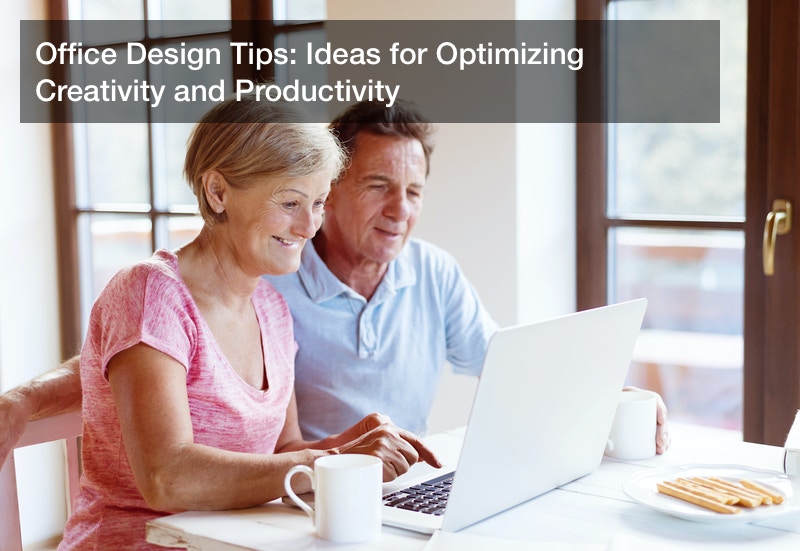
The work environment is responsible for virtually all aspects that could impact an employee’s productivity. That’s why it is essential to come up with a layout and design that will optimize the utility of a modern workspace. Here are some of the top office design tips.
Working on the Layout
It is essential to evaluate the factors that could influence the office design, especially when working on the layout. Some of those factors may include operations, the organization’s culture, and employees’ personalities, among other things.
Before you choose an open office plan, remember that they are not always the best option. While they were initially meant to facilitate collaboration, studies show that employees are less productive when sharing a workspace.
Modern offices create private spaces for employees with commercial glass doors and walls. If you are starting your business, you may not have the capital for expensive partitions.
In such instances, you may consider the following office design tips for suitable alternatives:
- Flexible Partitions: With this layout, you will have the usual standard plan, but you can move the walls when necessary. You could use partitions as barriers against noise and invasion of privacy. The advantage of this plan is that it caters to everyone. Introverted employees can work in their private rooms, while groups can collaborate in open spaces.
- Prefab Cubicles with High Ceilings: This type of office design is suited for workplaces situated on an old warehouse building. The walls are of an average height and a few meters below the ceiling. That allows natural light to spread across all the workspaces. One trendy idea is to accentuate the space with cathedral or pendant lighting. popular.
- Private Cubicles around a Work Area: The process of developing a layout has to factor socialization against the demand for privacy. One of the office design tips from experts is to build a central space for collaboration around work areas. Space also needs to be accessible to employees when they need to engage with colleagues.
Create Zones for Different Purposes

Before you think about creating zones, assess the activities you expect for that workspace. The purpose of that process is to facilitate different types of tasks taking place around the work areas. You may set aside zones to manage resources as well as minimize downtime.
Some of the expert office design tips include setting up:
- Touch-Down Areas: These are the sections of the workspace where workers can recharge. It may be a place where staff can prepare as they await the next shift. Touch-down areas need to be in places with a lot of positive energy.
- Hot-Desking: Hot desking is where employees do not have an allocated workstation but instead share with colleagues. Some organizations require staff to hot-desk every day, while others it is for a specified time. Hot-desking facilitates communication and encourages employees to interact. The type of design will depend on the operations in your industry.
Other than these areas, you can have places where employees can unwind. Research shows, it is essential for workers to have a place they can break for a while to relax and think. It could be an outdoor area with a garden and a peaceful stream or an indoor game room with pool tables.
Here are a few office design tips for creating social zones:
- Fun Zone: You may want to have an area where employees can take a break to unwind. The zone could be a gaming room or an indoor court with a basketball hoop.
- Collaboration Zones: You may also have areas to foster socialization. The ambiance should be casual, unlike the formal conference rooms. It may require a lot of natural light and air conditioning to manage cooling and heating.
- Quiet Zones: These places should ideally be away from all the noise and activity going on in the organization. They are areas set aside for thinking, meditation, and creative processes.
Enhance the Lighting

Taking advantage of natural light to minimize energy costs is another office design tip you can use. Contractors and designers will evaluate the orientation of the building and the presence of obstructions. Those factors are critical when you want to maximize sunlight exposure.
Another interior consideration is the placement of desks and work surfaces to the source of light. Ideally, work stations should be by the window or some natural source of light. Sufficient exposure to sunlight can encourage better sleep and minimize stress, thereby increasing productivity.
It is also advisable to consider different types of lighting and what role they play. For example, task lighting can facilitate focus and efficiency. The main aim of this type of fixture is to increase illumination. It enables workers to complete their jobs with ease, and it prevents eye strain.
However, task lighting is not the only kind of light you need. Without other sources to balance it out, there could be a lot of glare. Lampshades may help diffuse the light. It can reduce the unnecessary brilliance and flatter your office decor.
You also need to consider other sources of light and how they can influence the mood. Overhead lights can mellow the space to create an ambiance for staff to relax and think. It may be an ideal choice for quiet zones and meeting rooms.
One of the crucial office design tips for lighting is to assess the color and temperature of the lamp you intend to use. Warm colors and high-temperature fixtures are suitable for applications that require concentration and focus. On the other hand, cooler lighting is ideal for areas meant for relaxation.
For the office, you may adjust to warm colors in the early hours of the morning. Then set the lighting to gradually transition to cooler light towards the end of the workday.
Lighting affects every aspect of the employee’s well being, from productivity, safety to psychological health. Inadequate illumination may encourage rodents and mold, which will incur costs through pest control services.
Psychology of Color
If you are looking to redesign your workplace, it is wise to understand how color can impact productivity. Research shows that different colors have an effect on our psyche and can influence our behavior.
But before you apply any office design tips, you need to understand that they will affect different people differently. The influence of the color is not written in stone. So, you shouldn’t shy away from experimenting with your style.
There are many ways you can utilize color to enhance the interior space. You may opt to repaint the wall or replace your commercial interior doors. You may use centerpieces with a selection of colorful flowers. The possibilities are endless.
- Yellow: It is a popular color in entertainment and sports, as it conveys positivity and cheerfulness. You may consider having a splash of yellow for commercial flooring or walls. In collaboration zones, it can boost productivity and creativity.
- Blue: Blue communicates trust and promotes intellectual thought and calmness. It is an ideal choice for formal work areas and places for relaxation.
- Orange: Orange conveys friendliness, and it represents confidence and happiness. You can use it as an accent for modern spaces. One of the popular office design tips is to use it to highlight aesthetic elements of the interior with orange.
- Green: The color is associated with peacefulness, nature, and growth. It can improve creativity and promote a sense of calm. You may use white in the busy sections of the office. Researchers say it can reduce eye strain and fatigue.
- Purple: Purple is associated with wisdom, creativity, and imagination. Historically, artists have associated purple with wealth and royalty. One of the expert office design tips is to apply purple as a highlight. It can work for elegant modern spaces that need a feminine touch.
- White: White is a color that conveys spaciousness, balance, and neutrality. The best application for white is to use it for small spaces. It can make office spaces appear roomy. However, you need to be cautious about how you use the color. It can be uninspiring and bland, so consider balancing with other darker tones like grey, black, and blue.
- Black: Black exudes authority and sophistication. However, just like white, you should use it sparingly. An oversaturation of a dark color can result in a brooding and dark interior space. One of the expert office design tips is to use it for accents when you want to convey luxury and modern elegance. You may use a dash of it on the interior design elements around the reception and waiting areas.
Consider Incorporating Greenery

There is a myth that greenery can boost the indoor air quality of a room. But there is little evidence to support that claim. The amount of air that a plant can clean is negligible, particularly for busy work areas, such as the office.
However, it is still beneficial to have greenery on your work premises. Having well-cared-for plants can, indeed, improve productivity. Science indicates that employees who spend time around nature are likely to be more focused, relaxed, and productive. Studies also show it boosts creativity and brain function.
Consider incorporating plants with different heights and texture. Avoid the rigid arrangement that could make your indoor plants look like a plantation. The effect comes from how we perceive natural vegetation in the wild. That means your placement of flowers should be random across the office space.
Use low maintenance plants that can go for multiple days without water. Some of those plants may include cactus, aloe, and Pothos, amongst others. You may want to consider hiring someone to take care of the flowers and shrubs.
Commercial establishments have more elaborate irrigation systems than residential properties. Without maintenance, the plumbing can cause water damage and mold. Neglect may attract rodents or situations that may need the expertise of an air conditioning repair contractor.
If you can’t incorporate plants into the interior, one of the office design tips alternatives is to use patterns. You may install commercial flooring with vegetation or animal patterns. Using wallpapers is another option that is increasingly becoming popular for home offices. Such designs may be suitable for fun or collaboration zones.
Rethinking Conference Rooms
As you consider different office design tips, consider rethinking the layout of the conference rooms. It is estimated that we spend 35% of our work time in meetings with the supplier, business coach, or partner. Therefore, it is essential to reconsider the layout of the conference room.
A critical aspect of the meeting room is to clear the floor and make it visible. Even if you have a big conference room, it doesn’t mean you need a large table to fill the space. Also, when picking the table, ensure that everyone has a direct line of sight.
A curved or tear-drop shaped table is one way of increasing visibility. Consider getting multiple desks of small size for more flexible seating. Use warm and calming colors to promote a mood of alertness and calmness in the conference room. You may install boards near the commercial elevator to broadcast messages. Ensure there is adequate lighting to boost productivity.
Provide Room for Personalization

You may also want to encourage your staff to personalize the space with their decor. Employees may add family photos, art pieces, or souvenirs on their office wall or desk.
Research has shown that when employees want workspaces that support their self-image. Personalization elicits an intimate connection with the work area. It, therefore, increases efficiency and encourages collaboration. Engage them and share office design tips before starting the renovations.
Personalization may also include staff’s ability to move around the furniture. Staff need to have the power to determine their level of comfort. Ergonomic requirements may vary from one person to the next. It is, therefore, crucial that you give employees the ability to make the necessary adjustments.
Commercial glass walls and doors may also provide privacy and personalization for employees. You can adjust modern electronic-glass panels from opaque to transparent. You can utilize them to create versatile partitions while giving staff the option to customize their office.
There are many areas of the workplace you can change to refresh the interior and boost productivity. You can use the office design tips here as a framework. For the best results, allow staff to contribute and experiment with their unique styles.


